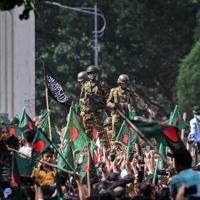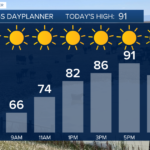Bangladesh’s army chief had a meeting scheduled with student protest leaders on Tuesday, following the military’s assumption of control due to mass demonstrations that drove longtime ruler Sheikh Hasina out of the country.
Hasina, who had been in power since 2009, was accused of election rigging in January, leading to protests over the past month demanding her resignation.
The unrest led to hundreds of deaths as security forces tried to suppress demonstrations, prompting Hasina to escape Bangladesh on a helicopter on Monday as the military rebelled against her.
Army chief General Waker-Uz-Zaman announced on state television that Hasina had resigned, and the military would establish a caretaker government.
“The country has faced significant challenges, with economic repercussions and loss of lives – it is time to end the violence,” said Waker, as jubilant crowds raided Hasina’s official residence.
Student protest leaders expressed interest in having Nobel laureate and microfinance pioneer Muhammad Yunus, 84, lead the government.
“We trust in Dr. Yunus,” said Asif Mahmud, a prominent member of the Students Against Discrimination (SAD) group, on Facebook.
Yunus has not responded to the proposal, but in an interview with India’s The Print, he spoke about Bangladesh’s liberation from Hasina’s regime.
– Violence –
The president and army chief met with President Mohammed Shahabuddin late Monday, along with key opposition figures, deciding to form an interim government promptly.
Millions of Bangladeshis gathered in Dhaka to celebrate after Waker’s announcement on Monday.
Sazid Ahnaf, 21, expressed joy, likening the events to the nation’s independence war against Pakistan over five decades ago, saying “We have been freed from a dictatorship.”
However, chaos and anger also ensued, with at least 109 reported casualties on Monday, including retaliatory attacks on Hasina’s supporters by mobs.
Monday marked the deadliest day since the protests began in July, with a total of at least 409 deaths, as reported based on various sources.
Protesters looted and set fire to various locations, including parliament and TV stations, as well as destroying statues of Hasina’s father, Sheikh Mujibur Rahman, the country’s independence hero.
Offices of Hasina’s Awami League across the nation were also targeted by arson and looting, according to eyewitnesses.
– Political prisoners freed –
The unrest initially began as protests against civil service job quotas and escalated into demands for Hasina’s resignation.
Her administration faced scrutiny from rights groups for allegedly misusing state resources to maintain power and suppress dissent, including through extrajudicial killings of opposition activists.
On Monday, the president, after meeting with army chief Waker, ordered the release of prisoners from the protests, as well as former prime minister and opposition leader Khaleda Zia, 78.
Zia, who is in poor health, was imprisoned by Hasina in 2018 on corruption charges.
Mothers of political prisoners detained under Hasina’s rule awaited news outside a military intelligence building in Dhaka on Tuesday, demanding answers.
The whereabouts of Hasina remain uncertain, as reports indicated she fled to a military airbase near New Delhi, with intentions to transit to London, although calls for an investigation into the violence may complicate this.
– Political vacuum –
Bangladesh has a history of coups, with the military declaring an emergency in 2007 and establishing a caretaker government for two years during political unrest.
Michael Kugelman from the Wilson Center warned that Hasina’s departure leaves a significant void, stating that the nation is in uncharted territory.
UN Secretary-General Antonio Guterres emphasized the need for a peaceful and democratic transition, while the European Union and other nations urged for calm during this critical period.
sa-pjm/mtp





